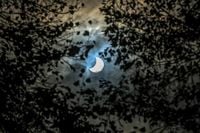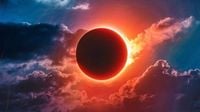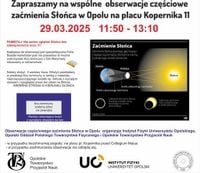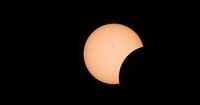A partial solar eclipse will be visible throughout Poland on March 29, 2025, offering a captivating astronomical event for skywatchers. According to the Astronomical Observatory of the University of Warsaw (OA UW), this celestial phenomenon will occur from 11:50 AM to 1:06 PM in the capital, with the maximum eclipse phase happening at 12:28 PM.
During this peak moment, approximately 15.6% of the Sun's disk will be obscured by the Moon, creating a sight likened to a "bitten cookie". While the eclipse will be less dramatic than in other regions, such as the Labrador Peninsula in Canada where up to 93.6% of the Sun will be covered, it still presents a unique opportunity for observation.
In Poland, the maximum eclipse visibility will vary, ranging from around 12% near Wrocław to 26% in Szczecin. In Warsaw, observers can expect about 16% coverage. The event will commence before 10:00 AM, with the total eclipse duration extending into the afternoon, wrapping up after 1:00 PM.
Weather conditions can significantly affect the viewing experience. Grażyna Dąbrowska, a meteorologist from the Institute of Meteorology and Water Management (IMGW), noted that the best places for clear skies will be in regions like Suwałki, Mazury, Mazowsze, Lublin, eastern Pomerania, and Kujawy. In contrast, areas like western Pomerania, Greater Poland, Lubusz Land, and Lower Silesia may experience more cloud cover, potentially obstructing the view.
For those eager to safely enjoy this astronomical spectacle, OA UW has organized a public viewing event at their headquarters located at Aleje Ujazdowskie 4 in Warsaw. Attendees will have access to telescopes and special solar viewing glasses, ensuring a secure experience as they watch the eclipse unfold. However, if weather conditions are poor, the event may be canceled.
Professor Tomasz Bulik, the director of OA UW, emphasized the rarity and significance of solar eclipses, stating, "Solar eclipses observable from Earth are exceptional events in our Solar System and perhaps among the nearest planetary systems." He pointed out that no other planet in our Solar System allows for such a precise obscuration of the Sun by its moon, not even Saturn, which boasts 274 natural satellites.
Looking ahead, another partial solar eclipse will occur on August 12, 2026, which will be visible from various locations in Europe, including Spain, where a total eclipse can be witnessed. The last total solar eclipse that could be seen from Poland was in 1954, with the next one not expected until 2135.
Understanding the nature of solar eclipses can enhance the viewing experience. They occur when the Moon passes between the Earth and the Sun, blocking sunlight partially or completely. There are three main types of solar eclipses: partial, total, and annular (or ring-like). A partial eclipse happens when the Moon covers only a portion of the Sun, while a total eclipse occurs when the Moon completely obscures the Sun. An annular eclipse takes place when the Moon is too far from Earth to cover the Sun fully, resulting in a ring of sunlight visible around the Moon.
Robert Szaj, an astronomy popularizer, noted that the partial eclipse on March 29 will serve as excellent preparation for the upcoming eclipse in August 2026. He remarked, "The observations in March will be excellent training for the next partial eclipse, which we will be able to observe in August 2026. This upcoming eclipse will take place just before sunset, which is already a spectacular sight, and even more beautiful when accompanied by a thin crescent of the Sun."
As excitement builds for this astronomical event, safety remains a paramount concern. Observers are strongly advised never to look directly at the Sun without proper eye protection. Special solar filters, resembling silver foil, are essential for safe viewing. These filters can be purchased at optical equipment stores or online.
In summary, the partial solar eclipse on March 29, 2025, offers an exciting opportunity for both seasoned astronomers and casual observers alike. With proper precautions and favorable weather, this event promises to be a memorable experience for all who participate.





